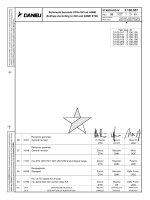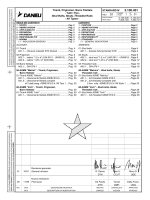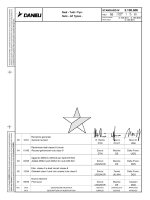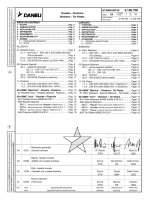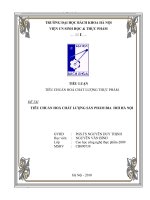TIÊU CHUẨN TIÊU CHUẨN A139
Bạn đang xem bản rút gọn của tài liệu. Xem và tải ngay bản đầy đủ của tài liệu tại đây (66.93 KB, 6 trang )
Designation: A 139 – 00
An American National Standard
Standard Specification for
Electric-Fusion (Arc)-Welded Steel Pipe (NPS 4 and Over)1
This standard is issued under the fixed designation A 139; the number immediately following the designation indicates the year of
original adoption or, in the case of revision, the year of last revision. A number in parentheses indicates the year of last reapproval. A
superscript epsilon (e) indicates an editorial change since the last revision or reapproval.
This standard has been approved for use by agencies of the Department of Defense.
2.3 ASME Standard:5
ASME Boiler and Pressure Vessel Code: Section IX, Welding Qualifications
1. Scope
1.1 This specification covers five grades of electric-fusion
(arc)-welded straight-seam or helical-seam steel pipe. Pipe of
NPS 4 (Note 1) and larger with nominal (average) wall
thickness of 1.0 in. (25.4 mm) and less are covered. Listing of
standardized dimensions are for reference (Note 2). The grades
of steel are pipe mill grades having mechanical properties
which differ from standard plate grades. The pipe is intended
for conveying liquid, gas, or vapor.
3. Ordering Information
3.1 Orders for material under this specification should
include the following, as required, to describe the desired
material adequately:
3.1.1 Quantity (feet or number of lengths),
3.1.2 Name of material (electric-fusion-(arc) welded steel
pipe),
3.1.3 Grade (Table 1),
3.1.4 Size (NPS, or outside diameter, and nominal wall
thickness, or schedule number),
3.1.5 Lengths (specific or random, Section 17),
3.1.6 End finish (Section 18),
3.1.7 Hydrostatic test pressure (Section 16, Note 8, and
Note 9),
3.1.8 ASTM specification designation, and
3.1.9 End use of material.
NOTE 1—The dimensionless designator NPS (nominal pipe size) has
been substituted in this standard for such traditional terms as “nominal
diameter,”“ size,” and “nominal size.”
NOTE 2—A comprehensive listing of standardized pipe dimensions is
contained in ANSI B 36.10.2
NOTE 3—The suitability of pipe for various purposes is somewhat
dependent on its dimensions, properties, and conditions of service. For
example, for high-temperature service see applicable codes and Specification A 691.
1.2 The values stated in inch-pound units are to be regarded
as the standard.
2. Referenced Documents
2.1 ASTM Standards:
A 370 Test Methods and Definitions for Mechanical Testing
of Steel Products2
A 691 Specification for Carbon and Alloy Steel Pipe, Electric Fusion-Welded for High-Pressure Service at High
Temperatures2
A 751 Test Methods, Practices, and Terminology for
Chemical Analysis of Steel Products2
E 59 Practice for Sampling Steel and Iron for Determination
of Chemical Composition3
2.2 American Welding Society Standard:4
ANSI/AWS B2.1 Standard for Welding Procedure and Performance Qualifications Welding Handbook, Vol 1, 8th ed
4. Process
4.1 The steel shall be made by one or more of the following
processes: open-hearth, basic-oxygen, or electric-furnace.
4.2 Steel may be cast in ingots or may be strand cast. When
steels of different grades are sequentially strand cast, identification of the resultant transition material is required. The
producer shall remove the transition material by any established procedure that positively separates the grades.
NOTE 4—The term “basic-oxygen steelmaking” is used generically to
describe processes in which molten iron is refined to steel under a basic
slag in a cylindrical furnace lined with basic refractories, by directing a jet
of high-purity gaseous oxygen onto the surface of the hot metal bath.
5. Manufacture
5.1 The longitudinal edges of the steel shall be shaped to
give the most satisfactory results by the particular welding
process employed. The weld shall be made by automatic (Note
5) means (except tack welds if used) and shall be of reasonably
uniform width and height for the entire length of the pipe.
1
This specification is under the jurisdiction of ASTM Committee A01 on Steel,
Stainless Steel, and Related Alloys, and is the direct responsibility of Subcommittee
A01.09 on Carbon Steel Tubular Products.
Current edition approved March 10, 2000. Published June 2000. Originally
published as A 139 – 32 T. Last previous edition A 139 – 96e1.
2
Annual Book of ASTM Standards, Vol 01.01.
3
Discontinued 1996; see 1995 Annual Book of ASTM Standards, Vol 03.05.
4
Available from American Welding Society, 550 NW LeJeune Rd., Miami, FL
33135.
NOTE 5—Upon agreement between the purchaser and the manufacturer,
5
Available from American Society of Mechanical Engineers, Three Park Ave.,
New York, NY 10016-5990.
Copyright © ASTM, 100 Barr Harbor Drive, West Conshohocken, PA 19428-2959, United States.
1
A 139
TABLE 1 Chemical Requirements
Element
7.2 The yield point shall be determined by the drop of the
beam, by the halt in the gage of the testing machine, by the use
of dividers, or by other approved methods. The yield strength
corresponding to a permanent offset of 0.2 % of the gage length
of the specimen, or to a total extension of 0.5 % of the gage
length under load shall be determined.
Composition, max, %
Carbon
Manganese
Phosphorus
Sulfur
Grade A
Grade B
Grade C
Grade D
Grade E
0.25
1.00
0.035
0.035
0.26
1.00
0.035
0.035
0.28
1.20
0.035
0.035
0.30
1.30
0.035
0.035
0.30
1.40
0.035
0.035
8. Tensile Requirements of Production Welds
8.1 Reduced-section tension test specimens taken perpendicularly across the weld in the pipe, with the weld reinforcement removed, shall show a tensile strength not less than 95 %
of the minimum specified in Section 7. At the manufacturer’s
option, the test may be made without removing the weld
reinforcement, in which case the tensile strength shall be not
less than that specified in Section 7.
manual welding by qualified procedure and welders may be used as an
equal alternative under these specifications.
5.2 All weld seams made in manufacturing pipe shall be
made using complete joint penetration groove welds.
6. Chemical Composition
6.1 The steel shall conform to the chemical requirements
prescribed in Table 1 and the chemical analysis shall be in
accordance with Test Methods, Practices, and Terminology
A 751.
9. Heat Analysis
9.1 An analysis of each heat of steel shall be made by the
manufacturer to determine the percentages of the elements
specified in Section 6. This analysis shall be made from a test
ingot taken during the pouring of the heat. When requested by
the purchaser, the chemical composition thus determined shall
be reported to the purchaser or his representative, and shall
conform to the requirements specified in Section 6.
7. Tensile Requirements for the Steel
7.1 Longitudinal tension test specimens taken from the steel
shall conform to the requirements as to tensile properties
prescribed in Table 2. At the manufacturer’s option, the tension
test specimen for sizes 85⁄8 in. (219.1 mm) in outside diameter
and larger may be taken transversely as described in 19.4.
10. Product Analysis
10.1 An analysis may be made by the purchaser on samples
TABLE 2 Tensile Requirements
Tensile strength, min, ksi (MPa)
Yield strength, min, ksi (MPa)
Elongation in 2 in. or 50 mm, min, %:
Basic minimum elongation for walls 5⁄16 in. (7.9 mm) and over in
thickness, longitudinal strip tests
For longitudinal strips tests, a deduction for each 1⁄32-in. (0.8-mm)
decrease in wall thickness below 5⁄16 in. (7.9 mm) from the
basic minimum elongation of the following percentageA
Elongation in 8 in. (203.2 mm), in min, %B,C
Grade A
48 (330)
30 (205)
Grade B
60 (415)
35 (240)
Grade C
60 (415)
42 (290)
Grade D
60 (415)
46 (315)
Grade E
66 (455)
52 (360)
35
30
25
23
22
1.75A
1.50A
1.25
1.50
2.0
1 500 000 specified tensile strength (psi)
A
The table below gives the computed minimum values.
B
For wall thicknesses 1⁄2in. (12.7 mm) and greater, the elongation may be taken in 8 in. (203.2 mm).
C
The elongation in 8 in. (203.2 mm) need not exceed 30 %.
Wall Thickness
Elongation in 2 in. or 50 mm, min, %
in.
mm
Grade A
Grade B
⁄ (0.312)
9⁄32 (0.281)
1⁄4 (0.250)
7⁄32 (0.219)
3⁄16 (0.188)
5⁄32 (0.156)
1⁄8 (0.125)
3⁄32 (0.094)
1⁄16 (0.062)
7.94
7.14
6.35
5.56
4.76
3.97
3.68
2.38
1.59
35.00
33.25
31.50
29.75
28.00
26.25
24.50
22.75
21.00
30.00
28.50
27.00
25.50
24.00
22.50
21.00
19.50
18.00
5 16
Note—The above table gives the computed minimum elongation values for each 1⁄32-in. (0.79-mm) decrease in wall thickness. Where the wall thickness lies between
two values shown above, the minimum elongation value shall be determined by the following equation:
Grade
A
B
C
D
E
E
E
E
E
E
where:
E 5 elongation in 2 in., %, and
t 5 actual thickness of specimen, in.
2
Equation
5 56t + 17.50
5 48t + 15.00
5 40t + 12.50
5 48t + 8
5 64t + 2
A 139
from the specified diameter as measured across any single
plane with a bar gage, caliper, or other instrument capable of
measuring actual diameter.
of pipe selected at random and shall conform to the requirements specified in Section 6. Samples for chemical analysis,
except for spectrochemical analysis, shall be taken in accordance with Method E 59. The number of samples shall be
determined as follows:
NPS
Under 14
14 to 36, incl
Over 36
12. Finish
12.1 Repair by Welding—The manual, or automatic arc,
welding of injurious defects in the pipe wall, provided their
depth does not exceed one third the specified wall thickness,
will be permitted. Defects in the welds, such as sweats or leaks,
shall be repaired or the piece rejected at the option of the
manufacturer. Repairs of this nature shall be made by completely removing the defect, cleaning the cavity, and then
welding.
12.2 All repaired pipe shall be tested hydrostatically in
accordance with Section 16.
Number of Samples Selected
2 for each lot of 200 pipes or fraction thereof
2 for each lot of 100 pipes or fraction thereof
2 for each 3000 ft or fraction thereof
10.2 Retests—If the analysis of either length of pipe or
length of skelp does not conform to the requirements specified
in Section 6, analyses of two additional lengths from the same
lot shall be made, each of which shall conform to the
requirements specified.
11. Dimensions, Weight, and Permissible Variations
11.1 Weight—The specified weight per unit length shall be
calculated using the following equation:
W 5 C~D 2 t!t
13. Retests
13.1 If any specimen tested under Sections 8 or 15 fails to
meet the requirements, retests of two additional specimens
from the same lot of pipe shall be made, all of which shall meet
the specified requirements. If any of the retests fail to conform
to the requirements, test specimens may be taken from each
untested pipe length, at the manufacturer’s option, and each
specimen shall meet the requirements specified, or that pipe
shall be rejected.
(1)
where:
C 5 10.69 (0.02466),
W 5 weight per unit length, lb/ft (kg/m),
D 5 outside diameter, in. (mm), specified or calculated
(from inside diameter and wall thickness), and
t 5 specified wall thickness, in. (to 3 decimal places)
(mm) (to 2 decimal places)
14. Number of Production Test Specimens
14.1 One longitudinal tension test specimen specified in
19.2 shall be made from the steel of each heat, or fraction
thereof, used in the manufacture of the pipe.
14.2 One reduced-section production weld test specimen
specified in 19.5 shall be taken from a length of pipe from each
lot of 3000 ft (914 m) of pipe, or fraction thereof, of each size
and wall thickness.
14.3 If any test specimen shows defective machining or
develops flaws not associated with the quality of the steel or the
welding, it may be discarded and another specimen substituted.
14.4 Each length of pipe shall be subjected to the hydrostatic test specified in Section 16.
NOTE 6—The weights given in the American National Standards and
the calculated weights given by the equation of 11.1 are based on the
weights for carbon steel pipe. The weight of pipe made of ferritic stainless
steels may be about 5 % less, and that made of austenitic stainless steel
about 2 % greater than the values given. The specified weight of an
individual pipe length shall be calculated as its specified weight per unit
length times its length.
11.1.1 The weight of any length of pipe shall not vary more
than 10 % over the specified weight.
11.1.2 The weight of any length of pipe shall not vary more
than 5 % under the specified weight when the specified wall
thickness is 0.188 in. (4.78 mm) or less or more than 5.5 %
under when the specified wall thickness is greater than 0.188
in. (4.78 mm).
11.1.3 The weight of a carload lot shall not vary more than
13⁄4 % under the specified weight. A carload lot is considered to
be a minimum of 40 000 lb (18 144 kg) shipped on a
conveyance.
11.2 Thickness—The minimum wall thickness at any point
shall be not more than 12.5 % under the nominal wall thickness
specified.
11.3 Circumference—The pipe shall be substantially round.
The outside circumference of the pipe shall not vary more than
61.0 %, but not exceeding 63⁄4 in. (19.0 mm), from the
nominal outside circumference based upon the diameter specified, except that the circumference at ends shall be sized, if
necessary, to meet the requirements of Section 18.
11.4 Straightness—Finished pipe shall be commercially
straight. When specific straightness requirements are desired,
the order should so state, and the tolerance shall be a matter of
agreement between the purchaser and the manufacturer.
11.5 Ovality (Out-of-Roundness)—The pipe diameter,
within 4.0 in. (100 mm) of ends, shall not vary more than 1 %
15. Qualification of Welding Procedure
15.1 Welding procedures shall be qualified in accordance
with the requirements of ANSI/AWS B2.1; ASME Boiler and
Pressure Vessel Code, Section IX; or other qualification procedures as noted in the American Welding Society Welding
Handbook. Tests and test values shall be as specified in 15.2
and 15.3.
15.2 Two reduced-section tension specimens made in accordance with Fig. 1, with the weld reinforcement removed, shall
show a tensile strength not less than 100 % of the minimum
specified tensile strength of the grade of steel used.
15.3 Bend test specimens (two face-bend and two root-bend
or four side-bend as designated by the welding procedure
according to thickness) shall be prepared in accordance with
Fig. 2 and shall withstand being bent 180° in a jig substantially
in accordance with Fig. 3. The bend test shall be acceptable if
no cracks or other defects exceeding 1⁄8 in. (3.2 mm) in any
direction are present in the weld metal or between the weld and
the pipe metal after bending. Cracks that originate along the
3
A 139
NOTE 9—When agreed upon by the purchaser and the manufacturer and
so stated on the order, pipe may be tested:
(1) To 11⁄2 times the specified working pressure, except that
the maximum test pressure shall not exceed 2800 psi (19.31
MPa) nor shall the maximum fiber stress exceed 85 % of
specified minimum yield point of the grade of steel used.
(2) To a fiber stress which does not exceed 85 % of the
specified minimum yield point of the grade of steel used or
exceed 2800-psi test pressure.
Metric Equivalents
in.
mm
1⁄4
6.4
0.01
0.3
11⁄2
38.1
10
254
17. Lengths
17.1 Pipe lengths shall be supplied in accordance with the
following regular practice:
17.1.1 Specific lengths shall be as specified on the order
with a tolerance of 61⁄2 in. (12.7 mm), except that the shorter
lengths from which test coupons have been cut shall also be
shipped.
17.1.2 Unless otherwise specified random lengths shall be
furnished in lengths averaging 29 ft (8.9 m) or over, with a
minimum length of 20 ft (6.1 m), but not more than 5 % may
be under 25 ft (7.6 m).
17.1.3 Pipe lengths containing circumferentially welded
joints (Note 6) shall be permitted by agreement between the
purchaser and the manufacturer. Tests of these welded joints
shall be made in accordance with the production weld tests
described in Section 8. The number of production weld tests
shall be one for each lot of 100 joints or fraction thereof, but
not less than one for each welder or welding operator.
FIG. 1 Reduced-Section Tension Test Specimen
Metric Equivalents
in.
mm
⁄
1.6
1 16
11⁄2
38.1
6
152.4
NOTE 1—Weld reinforcement may or may not be removed flush with
the surface of the specimen.
NOTE 2—Shown in Fig. 2 is a root- or face-bend specimen. Side-bend
specimens shall have a thickness (T) of 3⁄8 in. (9.5 mm) and a width equal
to the pipe wall thickness.
NOTE 10—Circumferentially welded joints are defined for the purpose
of these specifications as a welded seam lying in one plane, used to join
lengths of straight pipe.
FIG. 2 Guided-Bend Test Specimen
edges of the specimens during testing, and that are less
than 1⁄4 in. (6.3 mm) in any direction shall not be considered.
(If necessary, the specimen shall be broken apart to permit
examination of the fracture.)
18. Ends
18.1 Pipe shall be furnished with plain right-angle cut or
beveled ends as specified. All burrs at the ends of pipe shall be
removed.
18.2 When pipe is specified to have the ends prepared for
field welding of circumferential joints, the ends shall be
beveled on the outside to an angle of 35°, measured from a line
drawn perpendicular to the axis of the pipe, with a tolerance of
621⁄2° and with a width of root face (or flat at the end of the
pipe) of 1⁄16 6 1⁄32 in. (1.6 6 0.8 mm). Unless otherwise
specified, the outside circumference of pipe ends for a distance
of not less than 4 in. (101.6 mm) shall not vary more than
660 % of the nominal wall thickness of the pipe from the
nominal outside circumference based on the diameter specified, except that the tolerance shall be not less than 63⁄16 in.
(9.5 mm).
18.3 Pipe ends for use with mechanical couplings shall have
tolerances within the limits required by the manufacturer of the
type of coupling to be used.
18.4 Upon agreement between the purchaser and the manufacturer, the ends of the pipe may be sized within agreed-upon
tolerances, if necessary to meet the requirements of special
installations.
16. Hydrostatic Test (Note 7)
16.1 Each length of pipe shall be tested by the manufacturer
to a hydrostatic pressure that will produce in the pipe wall a
stress of not less than 60 % of the minimum specified yield
point at room temperature. The pressure shall be determined by
the following equation:
P 5 2St/D
(2)
where:
P 5 hydrostatic test pressure, psi (not to exceed 2800 psi
(19.3 MPa) in any case) (Note 8),
S 5 0.60 to 0.85 times the minimum specified yield point of
the grade of steel used in pounds per square inch,
t 5 specified wall thickness, in. and
D 5 specified outside diameter, in.
NOTE 7—A hydrostatic sizing operation is not to be considered a
hydrostatic test or a substitute for it.
NOTE 8—When the diameter and wall thickness of pipe are such that
the capacity limits of testing equipment are exceeded by these requirements, the test pressures may be reduced by agreement between the
purchaser and the manufacturer.
19. Production Test Specimens and Methods of Testing
19.1 The test specimens and the tests required by these
specifications shall conform to those described in Test Methods
16.2 Test pressure shall be held for not less than 5 s, or for
a longer time as agreed upon between the purchaser and the
manufacturer.
4
A 139
Metric Equivalents
in.
mm
⁄
1.6
1 16
⁄
3.2
18
⁄
6.4
14
3⁄8
9.5
1⁄2
12.7
3⁄4
19.0
7⁄8
22.2
2
50.8
FIG. 3 Jig for Guided-Bend Test
and Definitions A 370.
19.2 The longitudinal tension tests specimen of the steel
shall be taken from the end of the pipe in accordance with Fig.
4, or by agreement between the purchaser and the manufacturer, or may be taken from the skelp or plate, at a point which
will be approximately 90° of arc from the weld in the finished
pipe.
19.3 If the tension test specimen is taken transversely, the
specimen shall be taken in accordance with Fig. 5.
19.4 The specimens for the reduced-section tension test of
production welds shall be taken perpendicularly across the
weld at the end of the pipe. The test specimens shall have the
weld approximately in the middle of the specimen. The
specimens shall be straightened and tested at room temperature.
19.5 Reduced-section tension test specimens shall be prepared in accordance with Fig. 1.
FIG. 5 Location of Transverse Tension Test Specimen in Ring Cut
from Tubular Steel Products
unnecessarily with the operation of the works. If agreed upon,
the manufacturer shall notify the purchaser in time so that he
may have his inspector present to witness any part of the
manufacture or tests that may be desired.
20.2 Certification—Upon request of the purchaser in the
contract or order, a manufacturer’s certification that the material was manufactured and tested in accordance with this
specification together with a report of the chemical and tensile
tests shall be furnished.
20. Inspection
20.1 The inspector representing the purchaser shall have
entry, at all times while work on the contract of the purchaser
is being performed, to all parts of the manufacturer’s works
that concern the manufacture of the material ordered. The
manufacturer shall afford the inspector all reasonable facilities
to satisfy him that the material is being furnished in accordance
with this specification. All tests and inspection shall be made at
the place of manufacture prior to shipment and, unless otherwise specified, shall be so conducted as not to interfere
21. Rejection
21.1 Each length of pipe received from the manufacturer
may be inspected by the purchaser and, if it does not meet the
requirements of this specification based on the inspection and
test method as outlined in the specification, the length may be
rejected and the manufacturer shall be notified. Disposition of
rejected pipe shall be a matter of agreement between the
manufacturer and the purchaser.
21.2 Pipe found in fabrication or in installation to be
unsuitable for the intended use, under the scope and requirements of this specification, may be set aside and the manufacturer notified. Such pipe shall be subject to mutual investigation as to the nature and severity of the deficiency and the
forming or installation, or both, conditions involved. Disposition shall be a matter for agreement.
FIG. 4 Location from Which Longitudinal Tension Test
Specimens Are To Be Cut from Large Diameter Tubing
5
A 139
22. Protective Coating
22.1 If agreed upon between the purchaser and the manufacturer, the pipe shall be given a protective coating of the kind
and in the manner specified by the purchaser.
23.2 Bar Coding—In addition to the requirements in 23.1,
bar coding is acceptable as a supplemental identification
method. The purchaser may specify in the order a specific bar
coding system to be used.
23. Product Marking
23.1 Each section of pipe shall be marked with the manufacturer’s distinguishing marking, the specification number, the
grade of pipe, and other marking if required and agreed upon
between the purchaser and the manufacturer.
24. Keywords
24.1 arc welded steel pipe; fusion welded steel pipe; steel
pipe; welded steel pipe
The American Society for Testing and Materials takes no position respecting the validity of any patent rights asserted in connection
with any item mentioned in this standard. Users of this standard are expressly advised that determination of the validity of any such
patent rights, and the risk of infringement of such rights, are entirely their own responsibility.
This standard is subject to revision at any time by the responsible technical committee and must be reviewed every five years and
if not revised, either reapproved or withdrawn. Your comments are invited either for revision of this standard or for additional standards
and should be addressed to ASTM Headquarters. Your comments will receive careful consideration at a meeting of the responsible
technical committee, which you may attend. If you feel that your comments have not received a fair hearing you should make your
views known to the ASTM Committee on Standards, at the address shown below.
This standard is copyrighted by ASTM, 100 Barr Harbor Drive, PO Box C700, West Conshohocken, PA 19428-2959, United States.
Individual reprints (single or multiple copies) of this standard may be obtained by contacting ASTM at the above address or at
610-832-9585 (phone), 610-832-9555 (fax), or (e-mail); or through the ASTM website (www.astm.org).
6

